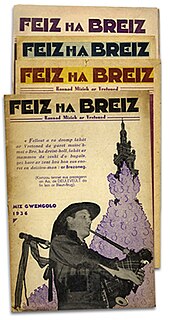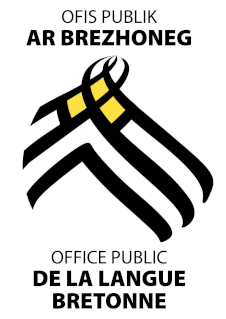 W
WBreton is a Southwestern Brittonic language of the Celtic language family spoken in Brittany, modern-day France. It is the only Celtic language still in use on the European mainland.
 W
WRonan Huon, also called René Huon,, was a Breton language writer and editor. He was director and chief editor of the magazine Al Liamm for over fifty years. His work has been recognized for its contribution to the Breton language and its literature.
 W
WCatholicon is a 15th-century dictionary written in Breton, French, and Latin. It is the first Breton dictionary and also the first French dictionary. It contains six thousand entries and was compiled in 1464 by the Breton priest Jehan Lagadeuc. It was printed in 1499 in Tréguier. A manuscript of the dictionary is preserved in the national library in Paris, identified as Latin 7656.
 W
WDiwan is a federation of Breton-medium schools in Brittany.
 W
W"Diwanit Bugale" was the French entry in the Eurovision Song Contest 1996, performed in Breton by Dan Ar Braz & L'Héritage des Celtes.
 W
WFeiz ha Breiz is the principal weekly journal in the Breton language. It originally appeared from 1865 to 1884, then was revived from 1899 to 1944, and then again from 1945 onwards.
 W
WFrance 3 Bretagne is one of France 3's regional services, broadcasting to people in the administrative region of Brittany. It was founded on February 2, 1964 as RTF Télé-Bretagne.
 W
WGoursez Vreizh is the national gorsedd of Brittany. It often has delegates from the Welsh gorsedd and Gorsedh Kernow in Cornwall. The Breton organisation is itself based on the Welsh-based Gorsedd, which was founded by Iolo Morganwg in 1792.
 W
WArnold von Harff was a German traveler from the 15th century, from Köln. He went on pilgrimage to many countries, collecting both languages and cultural information. He wrote about a number of languages during his travels (1496-1499) : Breton, Croatian, Turkish, Basque, Hebrew, Arabic, Albanian, Hungarian, Syriac, Amharic, and Armenian.
 W
WKendalc'h, is a confederacy of Celtic circles formed late 1950 in Quimper (Brittany). Kendalc'h promotes the Breton culture by means of the popular arts, based on eight radiuses of action: dance, costume, stage, street, youth, formation, music and publishing. It counts 180 Breton associations today, approximately 13,000 members, working in the domains of the Breton dance and the choral singing in Breton language. The other confederacy of Circles in Brittany is War'l Leur.
 W
WLower Brittany denotes the parts of Brittany west of Ploërmel, where the Breton language has been traditionally spoken, and where the culture associated with this language is most prolific. The name is in distinction to Upper Brittany, the eastern part of Brittany, which is of a predominantly Romance culture.
 W
WÑ is a letter of the modern Latin alphabet, formed by placing a tilde on top of an upper- or lower-case N. It became part of the Spanish alphabet in the eighteenth century when it was first formally defined, but it has subsequently been used in other languages, such as Galician, Asturian, the Aragonese Grafía de Uesca, Basque, Chavacano, some Philippine languages, Chamorro, Guarani, Quechua, Mapudungun, Mandinka, and Tetum alphabets, as well as in Latin transliteration of Tocharian and many Indian languages, where it represents or. It represents in Crimean Tatar, ALA-LC romanization for Turkic languages, the Common Turkic Alphabet, Nauruan and romanized Quenya. In Breton and in Rohingya, it denotes nasalization of the preceding vowel. Many Portuguese speakers use this letter in informal internet language to represent the word não (no).
 W
WThe Public Office for the Breton Language was established on 15 October 2010 as a public institution, with state and regional cooperation and funding, to promote and develop teaching and use of the Breton language in daily life. It is an example of language revival efforts for minority languages in France.
 W
WSpilhennig is a logo created in 2007 for speakers of Breton by the Office of the Breton Language. The logo was created to be worn such that those that speak the language can recognize other speakers and converse in it, rather than converse out of ignorance in the majority language of the Breton region, French. The logo is designed to look like a wave, representing modern-day Breton, and an eye, representing the logo's ability to allow speakers to visually see other speakers.
 W
WThe symbole, also called ar vuoc'h, was an object used by Francophone headmasters in public and private schools in Brittany, French Flanders, Occitania, Basque Country and North Catalonia as a means of punishment for students caught speaking Breton, Flemish, Occitan or Catalan during the 19th and 20th centuries.
 W
WTrégorrois Breton is the dialect of Breton spoken in Trégor.
 W
WWar'l Leur is a confederacy of Celtic circles established in late 1967. Other confederacy in Brittany is Kendalc'h. The association gathers a large number of groups of Breton traditional dance which propose shows and animations throughout the Brittany region, in particular in summer, but also elsewhere in France, Europe and abroad.